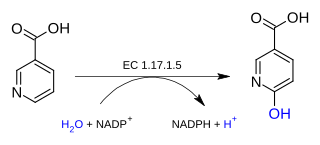
In enzymology, a 3-hydroxyacyl-CoA dehydrogenase (EC 1.1.1.35) is an enzyme that catalyzes the chemical reaction

In enzymology, a 3-hydroxybutyryl-CoA dehydrogenase (EC 1.1.1.157) is an enzyme that catalyzes the chemical reaction

In enzymology, a nicotinate dehydrogenase is an enzyme that catalyzes the chemical reaction
The enzyme formyl-CoA hydrolase (EC 3.1.2.10) catalyzes the reaction

Butyryl-CoA is an organic coenzyme A-containing derivative of butyric acid. It is a natural product found in many biological pathways, such as fatty acid metabolism, fermentation, and 4-aminobutanoate (GABA) degradation. It mostly participates as an intermediate, a precursor to and converted from crotonyl-CoA. This interconversion is mediated by butyryl-CoA dehydrogenase.
In enzymology, a 2-ethylmalate synthase (EC 2.3.3.6) is an enzyme that catalyzes the chemical reaction

In enzymology, an acetyl-CoA C-acetyltransferase is an enzyme that catalyzes the chemical reaction
In enzymology, an arylamine N-acetyltransferase is an enzyme that catalyzes the chemical reaction

Carnitine O-acetyltransferase also called carnitine acetyltransferase is an enzyme that encoded by the CRAT gene that catalyzes the chemical reaction
In enzymology, a citrate (Re)-synthase (EC 2.3.3.3) is an enzyme that catalyzes the chemical reaction
In enzymology, a glucosamine-1-phosphate N-acetyltransferase is an enzyme that catalyzes the chemical reaction

In enzymology, glucosamine-phosphate N-acetyltransferase (GNA) is an enzyme that catalyzes the transfer of an acetyl group from acetyl-CoA to the primary amine in glucosamide-6-phosphate, generating a free CoA and N-acetyl-D-glucosamine-6-phosphate.
In enzymology, a glutamate N-acetyltransferase (EC 2.3.1.35) is an enzyme that catalyzes the chemical reaction
In enzymology, a glycine C-acetyltransferase is an enzyme that catalyzes the chemical reaction:

In enzymology, a homocitrate synthase (EC 2.3.3.14) is an enzyme that catalyzes the chemical reaction
In enzymology, a hydrogen-sulfide S-acetyltransferase is an enzyme that catalyzes the chemical reaction

In enzymology, a lysine N-acetyltransferase (EC 2.3.1.32) is an enzyme that catalyzes the chemical reaction
In enzymology, a sulfoacetaldehyde acetyltransferase is an enzyme that catalyzes the chemical reaction
In enzymology, a thioethanolamine S-acetyltransferase is an enzyme that catalyzes the chemical reaction

Earl Reece Stadtman NAS was an American biochemist, notable for his research on enzymes and anaerobic bacteria.











